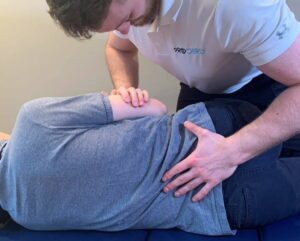What is a Chiropractic Adjustment?
In general practice one of the questions I get asked the most is \”What is an Adjustment?\” It is probably the treatment technique we use in the clinic that is the least well understood by patients. This misunderstanding of what an adjustment is can also create fear. The purpose of this blog post is to answer some questions as to what an adjustment actually is.
So, What Actually Is A Chiropractic Adjustment?
An adjustment is a treatment technique that chiropractors, osteopaths and some physiotherapists use to improve movement in stiff joints. You may also hear the term manipulation which means the same thing. Adjustments are primarily used in the back but we also use adjustments in extremity joints of the body, such as the foot, ankle, knee, shoulder and elbow.
What Is The Cracking Noise?
During an adjustment, there may or may not be a cracking noise produced by the joint we are adjusting. This cracking noise sounds very dramatic and important, but is in no way linked to the beneficial effects of the adjustment.
The cracking noise is produced by a bubble of gas inside the joint that gets released during the adjustment. During the adjustment this bubble of gas forms, and then very quickly the bubble \”implodes\” and pops. The cracking noise is just this gas bubble imploding. Its the same noise as when you click and crack your knuckles.

A photo of our sports Chiropractor Josh French performing a Lumbar spine adjustment.
A video of our sports chiropractor Josh French explaining more about what adjustments are.
How Do Adjustments Work?
The way adjustments work isn’t fully understood yet, but we have a pretty good guess. People used to believe adjustments literally pushed a bone or joint back into place, but we know now with all the medical imaging we have available that this isn\’t the case.
The main theories for how adjustments work suggest two different mechanisms.
- Firstly, adjustments help to reduce muscle tension in the area surrounding the adjustment. This is thought to occur because during an adjustment the brain receives lots of signals from the affected area. The brain then sends signals back down to the area telling the muscles to relax.
- Secondly, adjustments help to reduce pain but improve movement from the affected area. For example, for someone with low back pain, the muscles and joints in their back will be sending lots of signals to the brain that the brain perceives as painful. During the adjustment the brain then receives new signals regarding the movement from the joint. The new signals effectively override the old signals that the brain interpreted as painful. Due to this, the brain stops perceiving the other signals as painful. The effect of this is decreased pain and improved movement.
Are Adjustments Safe?
On the whole, adjustments are a very safe form of treatment. For the average person with low back pain, the risks associated with taking ibuprofen would be higher than the risks associated with a low back adjustment. Adjustments might seem scary and painful, but there is normally no pain linked with an adjustment. In fact, in most cases pain levels are instantly reduced following an adjustment.
Remember to like and follow our facebook page to stay tuned with our updates, and if you have any questions please feel free to get in touch.




